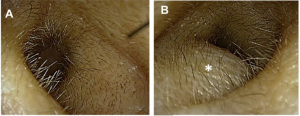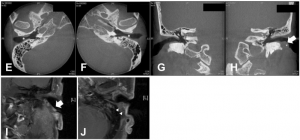Coronavirus disease 2019 (COVID-19) can cause various systemic complications In the field of otorhinolaryngology, taste, and olfactory disorder. Although it is less common than taste and olfactory abnormalities, COVID-19 issues can also lead to hearing loss since the SAR-CoV-2 virus can be found in the middle ear canal and the mastoid cavity of COVID-19 patients.
One of the many systemic complications of COVID-19 is thrombosis, with deep vein or lung thrombosis having the highest death rate.2 4.4% of patients with the severe COVID-19 disease showed evidence of thrombosis.3 The proinflammatory, milieu-mediated and hypercoagulable state of COVID-19, which is defined by micro and macrovascular thrombotic angiopathy, can also lead to thrombosis in various organs, from thin veins to thick arteries.
A highly rare case of external ear canal stenosis brought on by arterial thrombosis following COVID-19 infection is discussed in a recently published case study. It is most likely the first account of external ear stenosis associated with COVID-19 and can aid medical professionals in the future with the diagnosis and treatment of cases of this nature.
Case presentation:
What was the patient’s chief complaint and medical history
A 62 years old patient who was treated for severe COVID-19 with acute respiratory distress syndrome (ARDS) for four weeks, roughly 11 months prior, came to the Keio University School of Medicine with the presentation of left tinnitus and left ear fullness.
Computed tomography (CT) pictures from the time of his diagnosis and COVID-19 treatment in the previous hospital revealed a crazy-paving pattern in the bilateral lung along with high ferritin (3344 ng/ml) and soluble interleukin 2 receptors (sIL2R) levels (1099 U/l) in peripheral blood tests. He was treated with extracorporeal membrane oxygenation (ECMO) care for COVID-19 in the hospital for almost two weeks and is now experiencing erectile dysfunction since he got infected with it.
What did clinicians find on physical and radiological examination?
Clinical examination of the patient indicated a more severe bilateral ear stenosis on the left side, resulting in a noticeably smaller external ear canal on that side. He also experienced left mixed hearing loss and right sensorineural hearing loss. Prior to contracting COVID-19, he had been told by medical professionals that neither of his external ear canals had any stenosis.
There were no invasive mass lesions in the external ear canal, but microcalcifications were found in the left ear canal, which is where the subcutaneous mass was placed on computed tomography (CT) pictures and the same could be seen in magnetic resonance imaging (MRI) data with enhanced quality of structures.

Fig. 1: Bilateral ear canal stenosis seen on clinical examination

Fig. 2: CT scan images show bilateral external ear canal stenosis without accompanying bony destruction
Management of external ear canal stenosis in COVID-19-treated patients
Surgery was used to successfully treat the patient’s bilateral external ear canal stenosis because the etiology was unknown. In order to reduce ear fullness and enlarge the external ear canal to enhance hearing, the surgeons conducted a resection for the left ear’s external canal stenosis.
Under general anesthesia, more significant stenosis was seen when the outer ear canal was incised, and a spherical mass was encountered in the narrowest region of this canal. It was simple to separate from the surrounding subdermal tissues, and the perichondrium from the tragus was applied to the external canal’s exposed bony wall and fixed with fibrin glue. After a 6 month follow up, the patient’s left ear external canal was found much wider than before the surgery.
What did the biopsy reveal?
The biopsy results assisted in excluding neoplastic lesions or other benign tumors as potential causes of external ear canal stenosis. The excised tissue was mainly composed of a thrombosis that developed in the artery, according to the histopathological examination. the combined clinical and histological results concluded that the mass brought on by a COVID-19-related arterial thrombosis of the external ear canal was indicated to have induced an external ear canal stenosis.

Fig. 3: Hematoxylin–eosin staining revealed the presence of red blood cells around an organized thrombus
Why is this case report so important?
This report discusses a case of histologically proven external auditory canal arterial thrombosis in a patient who suffered from COVID-19 and had no prior history of coagulopathy or thrombosis. And hence, we concluded that the external canal thrombosis is a symptom of COVID 19. Patients’ additional complaint, such as erectile dysfunction following COVID 19, is suggestive of the presence of systemic thrombosis.
According to the information that is available, this is the first instance of external ear canal stenosis associated with COVID-19. In this case, arterial thrombosis in the external ear canal is visible, and histological findings support the development of arterial thrombosis in the external ear canal following COVID-19 treatment. This finding led to the conclusion that thrombosis might arise in the temporal bone region similarly to other organs, following COVID-19. One of the many otological symptoms of arterial thrombosis is ischemia in the area of the temporal bone, which may one day be used to investigate or explain the many otological symptoms following COVID-19 infections.
There have already been several reports of COVID-19-related otological problems in the inner or middle ear. This report shows that thrombotic events with COVID can affect a wide range of body areas, including the subcutaneous tissue surrounding the outer ear. It also tells about the significance of a detailed examination of the external ear canal when patients look for medical attention for otological symptoms following COVID-19 as there may be canal stenosis or narrowing linked to thrombosis brought on by COVID-19.
References:
- https://pubmed.ncbi.nlm.nih.gov/32701126/
- https://pubmed.ncbi.nlm.nih.gov/32882719/
- https://pubmed.ncbi.nlm.nih.gov/32866574/
- https://www.ncbi.nlm.nih.gov/pmc/articles/PMC9168405/#bibr1-01455613221097198

MDForLives is a vibrant community of healthcare professionals and patients dedicated to shaping the future of healthcare. We provide valuable global insights to healthcare companies through online surveys, interviews, and discussion forums.






